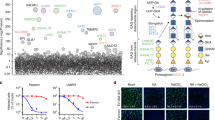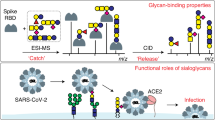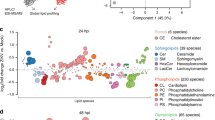Abstract
Cellular susceptibility to viral infections is in part determined by the presence of a host cellular receptor. Here we use murine norovirus as a model to uncover an unappreciated connection between an intracellular lipid biosynthetic enzyme and a receptor conformation that is permissive for viral infection. The serine palmitoyltransferase complex is required for de novo sphingolipid biosynthesis and we find that its absence impairs the ability of murine norovirus to bind and enter cells. Although the serine palmitoyltransferase complex is dispensable for the surface expression of the norovirus receptor, CD300lf, serine palmitoyltransferase activity is required for CD300lf to adopt a conformation permissive for viral binding. Addition of extracellular ceramide to serine palmitoyltransferase-deficient cells chemically complements both the conformational changes of CD300lf and the cellular susceptibility to murine norovirus infection. Taken together, these data indicate that intracellular sphingolipid biosynthesis regulates the conformation of the murine norovirus receptor and therefore the tropism of murine norovirus. This indicates that intracellular biosynthetic pathways can regulate viral tropism even when the receptor for a virus is expressed on the target cell surface.
This is a preview of subscription content, access via your institution
Access options
Access Nature and 54 other Nature Portfolio journals
Get Nature+, our best-value online-access subscription
$29.99 / 30 days
cancel any time
Subscribe to this journal
Receive 12 digital issues and online access to articles
$119.00 per year
only $9.92 per issue
Buy this article
- Purchase on Springer Link
- Instant access to full article PDF
Prices may be subject to local taxes which are calculated during checkout




Similar content being viewed by others
References
Glass, R. I., Parashar, U. D. & Estes, M. K. Norovirus gastroenteritis. N. Engl. J. Med. 361, 1776–1785 (2009).
Bok, K. & Green, K. Y. Norovirus gastroenteritis in immunocompromised patients. N. Engl. J. Med. 367, 2126–2132 (2012).
Karst, S. M., Wobus, C. E., Goodfellow, I. G., Green, K. Y. & Virgin, H. W. Advances in norovirus biology. Cell Host Microbe 15, 668–680 (2014).
Guix, S. et al. Norwalk virus RNA is infectious in mammalian cells. J. Virol. 81, 12238–12248 (2007).
Orchard, R. C. et al. Discovery of a proteinaceous cellular receptor for a norovirus. Science 353, 933–936 (2016).
Haga, K. et al. Functional receptor molecules CD300lf and CD300ld within the CD300 family enable murine noroviruses to infect cells. Proc. Natl Acad. Sci. USA 113, E6248–E6255 (2016).
Lindesmith, L. et al. Human susceptibility and resistance to Norwalk virus infection. Nat. Med. 9, 548–553 (2003).
Kambhampati, A., Payne, D. C., Costantini, V. & Lopman, B. A. Host genetic susceptibility to enteric viruses: a systematic review and metaanalysis. Clin. Infect. Dis. 62, 11–18 (2016).
Wobus, C. E. et al. Replication of Norovirus in cell culture reveals a tropism for dendritic cells and macrophages. PLoS Biol. 2, e432 (2004).
Karst, S. M., Wobus, C. E., Lay, M., Davidson, J. & Virgin, H. W. STAT1-dependent innate immunity to a Norwalk-like virus. Science 299, 1575–1578 (2003).
Hanada, K. Serine palmitoyltransferase, a key enzyme of sphingolipid metabolism. Biochim. Biophys. Acta 1632, 16–30 (2003).
Montes, L. R., Ruiz-Argüello, M. B., Goñi, F. M. & Alonso, A. Membrane restructuring via ceramide results in enhanced solute efflux. J. Biol. Chem. 277, 11788–11794 (2002).
Stancevic, B. & Kolesnick, R. Ceramide-rich platforms in transmembrane signaling. FEBS Lett. 584, 1728–1740 (2010).
Fucho, R., Casals, N., Serra, D. & Herrero, L. Ceramides and mitochondrial fatty acid oxidation in obesity. FASEB J. 31, 1263–1272 (2017).
Gomez-Muñoz, A. et al. Control of inflammatory responses by ceramide, sphingosine 1-phosphate and ceramide 1-phosphate. Prog. Lipid Res. 61, 51–62 (2016).
Galadari, S., Rahman, A., Pallichankandy, S. & Thayyullathil, F. Tumor suppressive functions of ceramide: evidence and mechanisms. Apoptosis 20, 689–711 (2015).
Lowther, J. et al. Role of a conserved arginine residue during catalysis in serine palmitoyltransferase. FEBS Lett. 585, 1729–1734 (2011).
Izawa, K. et al. The receptor LMIR3 negatively regulates mast cell activation and allergic responses by binding to extracellular ceramide. Immunity 37, 827–839 (2012).
Jones, M. K. et al. Enteric bacteria promote human and mouse norovirus infection of B cells. Science 346, 755–759 (2014).
Ettayebi, K.et al. Replication of human noroviruses in stem cell-derived human enteroids. Science 353, 1387–1393 (2016).
Schneider-Schaulies, J. & Schneider-Schaulies, S. Sphingolipids in viral infection. Biol. Chem. 396, 585–595 (2015).
Luisoni, S. et al. Co-option of membrane wounding enables virus penetration into cells. Cell Host Microbe 18, 75–85 (2015).
Otsuki, N. et al. Both Sphingomyelin and Cholesterol in the Host Cell Membrane Are Essential for Rubella Virus Entry. J Virol. 92, 17 (2018).
Contreras, F. X. et al. Molecular recognition of a single sphingolipid species by a protein’s transmembrane domain. Nature 481, 525–529 (2012).
García-Arribas, A. B., Alonso, A. & Goñi, F. M. Cholesterol interactions with ceramide and sphingomyelin. Chem. Phys. Lipids 199, 26–34 (2016).
Wei, W. et al. ICAM-5/Telencephalin is a functional entry receptor for Enterovirus D68. Cell Host Microbe 20, 631–641 (2016).
Farzan, M. et al. Tyrosine sulfation of the amino terminus of CCR5 facilitates HIV-1 entry. Cell 96, 667–676 (1999).
Strong, D. W., Thackray, L. B., Smith, T. J. & Virgin, H. W. Protruding domain of capsid protein is necessary and sufficient to determine murine norovirus replication and pathogenesis in vivo. J. Virol. 86, 2950–2958 (2012).
Hwang, S. et al. Murine norovirus: propagation, quantification, and genetic manipulation. Curr. Protoc. Microbiol. 33, 15K.2.1–15K.2.61 (2014).
Baert, L. et al. Detection of murine norovirus 1 by using plaque assay, transfection assay, and real-time reverse transcription-PCR before and after heat exposure. Appl. Environ. Microbiol. 74, 543–546 (2008).
Acknowledgements
We would like to thank Leon Hsieh for technical assistance for MNoV binding assay. R.C.O. was supported by NIH grant K99 DK116666. C.B.W was supported by NIH grant K08 AI128043. H.W.V. was supported by NIH grants U19 AI10972505 and R01 AI127552.
Author information
Authors and Affiliations
Contributions
R.C.O. designed, performed and analysed the experiments and wrote the manuscript. C.W.B. and H.W.V. designed and analysed the experiments. All authors read, discussed and edited the manuscript.
Corresponding authors
Ethics declarations
Competing interests
Washington University School of Medicine holds patents on several aspects of murine norovirus. These have been licensed, generating income for the University and the inventors, including H.W.V.
Additional information
Publisher’s note: Springer Nature remains neutral with regard to jurisdictional claims in published maps and institutional affiliations.
Supplementary information
Supplementary Information
Supplementary Figs 1 and 2.
Rights and permissions
About this article
Cite this article
Orchard, R.C., Wilen, C.B. & Virgin, H.W. Sphingolipid biosynthesis induces a conformational change in the murine norovirus receptor and facilitates viral infection. Nat Microbiol 3, 1109–1114 (2018). https://doi.org/10.1038/s41564-018-0221-8
Received:
Accepted:
Published:
Issue Date:
DOI: https://doi.org/10.1038/s41564-018-0221-8
This article is cited by
-
CLIC and membrane wound repair pathways enable pandemic norovirus entry and infection
Nature Communications (2023)
-
A global lipid map defines a network essential for Zika virus replication
Nature Communications (2020)
-
Greasing the receptor
Nature Microbiology (2018)



